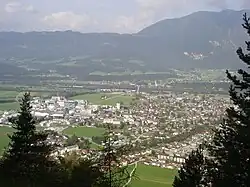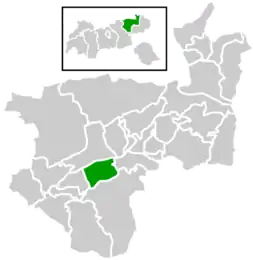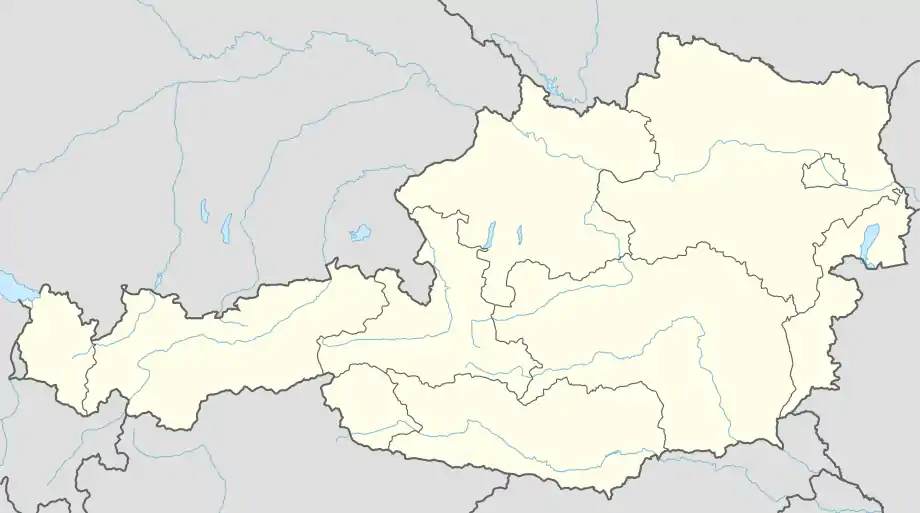Kundl | |
|---|---|
 Kundl | |
 Coat of arms | |
 Location within Kufstein district | |
 Kundl Location within Austria | |
| Coordinates: 47°28′00″N 11°59′00″E / 47.46667°N 11.98333°E | |
| Country | Austria |
| State | Tyrol |
| District | Kufstein |
| Government | |
| • Mayor | Anton Hoflacher (SPÖ) |
| Area | |
| • Total | 21.94 km2 (8.47 sq mi) |
| Elevation | 526 m (1,726 ft) |
| Population (2018-01-01)[2] | |
| • Total | 4,464 |
| • Density | 200/km2 (530/sq mi) |
| Time zone | UTC+1 (CET) |
| • Summer (DST) | UTC+2 (CEST) |
| Postal code | 6250 |
| Area code | 05338 |
| Vehicle registration | KU |
| Website | www.kundl.tirol.gv.at |
Kundl is a market town in the Kufstein district in the Austrian state of Tyrol.
Geography
Kundl is situated 7.70 km west of Wörgl as well as 18.30 km southwest of Kufstein at the southern side of the Inn River and is made up of 4 parts, namely Kundl, Liesfeld (in the north), Saulueg (in the south) and St. Leonhard (in the west).
Neighbouring municipalities
History
Eastward of Kundl some cremation graves with other remains were found which dated from the La Tène Culture and are now publicly exhibited in the Landesmuseum Ferdinandeum in Innsbruck.
Kundl was first mentioned in a directory by bishop Arno of Salzburg in 788 under the name ad Quantalas, which means at the white river. This should also be the origin of the current name of the market town. In 1213 the noble line of the Kummersbrucker resided in the fortress of Kundl, of which nowadays only the ruins remain. In the 15th and 16th century the mining gained importance and some current street names (e.g. Hüttstraße, Schieferrollstraße) still bear evidence of that.
In 1658 Bartlmä Plank founded a brewery which produced the Kundler Bier. This brewery was converted into a pharmaceutical plant, the Biochemie Kundl, in 1946 nowadays Sandoz.
Nowadays
Due to the settlements of several companies in the 1950s, the village became a commuter community. The most well- known companies in Kundl are probably the pharmaceutical company Sandoz (former: Biochemie), the tractor factory Lindner and the timber factory Pfeifer.
In the summer a lot of tourists visit Kundl and stroll through the picturesque gorge of Kundl, in German called Kundler Klamm, which connects Kundl with the valley of Wildschoenau.
Population
| Year | Pop. | ±% |
|---|---|---|
| 1869 | 865 | — |
| 1880 | 911 | +5.3% |
| 1890 | 920 | +1.0% |
| 1900 | 1,183 | +28.6% |
| 1910 | 1,443 | +22.0% |
| 1923 | 1,438 | −0.3% |
| 1934 | 1,765 | +22.7% |
| 1939 | 1,934 | +9.6% |
| 1951 | 2,121 | +9.7% |
| 1961 | 2,508 | +18.2% |
| 1971 | 3,089 | +23.2% |
| 1981 | 3,267 | +5.8% |
| 1991 | 3,468 | +6.2% |
| 2001 | 3,716 | +7.2% |
| 2013 | 4,034 | +8.6% |
Miscellaneous
- During the Second World War, the bronze statues of the emperor Maximilian I, which are now on display at the Hofkirche, Innsbruck, were kept in a cave in Kundl.
- In 1951 the two chemists Hans Margreiter and Ernst Brandl developed Penicillin V in Kundl and from this time on the drug could be administered orally.
Gallery
 Kundl, church: Katholische Pfarrkriche Mariä Himmelfahrt
Kundl, church: Katholische Pfarrkriche Mariä Himmelfahrt Church of St. Leonhard.
Church of St. Leonhard. Kundl, river (der Inn) from the bridge
Kundl, river (der Inn) from the bridge
References
- ↑ "Dauersiedlungsraum der Gemeinden Politischen Bezirke und Bundesländer - Gebietsstand 1.1.2018". Statistics Austria. Retrieved 10 March 2019.
- ↑ "Einwohnerzahl 1.1.2018 nach Gemeinden mit Status, Gebietsstand 1.1.2018". Statistics Austria. Retrieved 9 March 2019.
External links
- Website of Kundl (in German)
- The Kundl Tourist Board Archived 2011-07-26 at the Wayback Machine